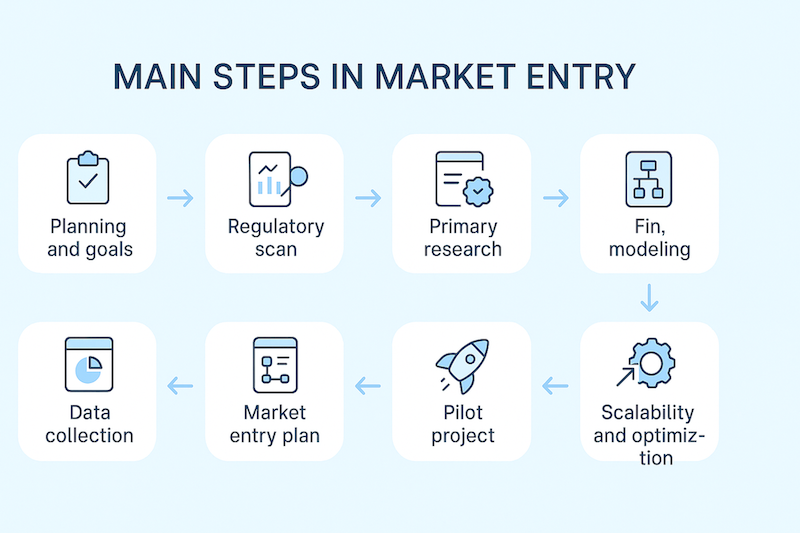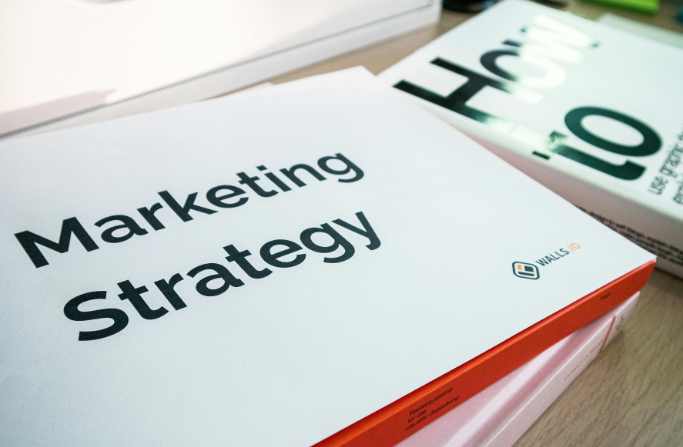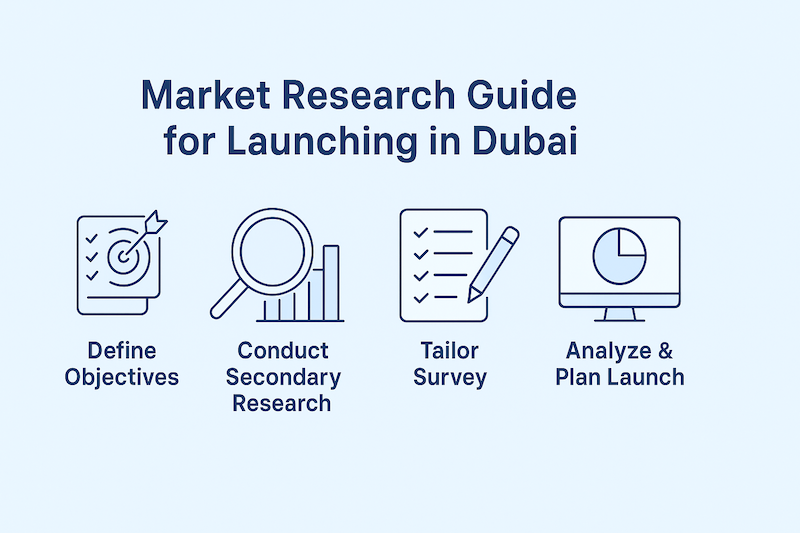Why This Market Research Guide Matters
Dubai is one of the world’s most ambitious and multicultural business hubs. Every week, new brands enter the emirate — from fintech startups to luxury retailers. Yet not all succeed. Why? Because many underestimate the complexity of this market.
This market research guide is designed to help businesses, investors, and entrepreneurs navigate Dubai’s fast-paced environment. Tailored intelligence is not a luxury here — it is the foundation for making informed decisions.
Businesses entering Dubai without structured research often “skip steps,” leading to costly mistakes such as opening under the wrong license, misjudging cultural factors, or targeting the wrong consumer group.

B2C Market Research in UAE & Saudi Arabia
The Big Picture: Why Dubai?
Dubai is more than just a city — it’s a business ecosystem shaped by economic diversification, digital transformation, and global connectivity.
- SME Growth: Over 95% of Dubai’s businesses are SMEs, creating vibrant competition but also collaboration opportunities.
- Population Diversity: With more than 400 nationalities represented, no other global hub combines such diversity with concentrated purchasing power.
- Upcoming Projects: From Expo 2020 legacy sites to new smart city initiatives, Dubai’s infrastructure continues to generate demand across retail, fintech, energy, and creative sectors.
As Vogue Business noted, the emirate is not just expanding but reshaping entire industries — particularly luxury, beauty, and experiential retail.

Market Entry Action Plan UAE market
Step-by-Step Market Research Guide for Dubai
Yardstick Marketing outlined seven key steps for effective research, which can be adapted for Dubai’s context:
- Define Objectives Clearly – What problem are you solving? What customer need are you addressing?
- Scan the Market – Use secondary sources like Dubai Statistics Center, Department of Economic Development (DED), and retail reports.
- Design Research Frameworks – Tailor surveys and focus groups to Dubai’s multilingual and multicultural population.
- Conduct Primary Research – B2B: expert interviews, consultations; B2C: product testing, focus groups, mystery shopping.
- Analyze Competitors – Benchmark pricing, branding, and consumer perception of incumbents.
- Validate Findings – Cross-check with secondary data, trade associations, and government reports.
- Translate Insights Into Action – Build a feasibility study, financial plan, and entry strategy.
Primary vs. Secondary Research in Dubai

Launch of business or product in Dubai UAE KSA steps
Secondary data is limited, but not absent. Reliable sources include:
- Dubai Statistics Center
- Dubai Chamber of Commerce reports
- Department of Economy & Tourism (DET) market updates
- Sectoral reports by agencies like Nielsen, Ipsos, or TGM Research
However, secondary data often lacks nuance. That’s why primary research — through interviews, consumer surveys, and in-market observations — is indispensable. For example, during the Dubai Shopping Festival or Ramadan Celebration (Eid Holidays), consumer behavior shifts significantly, and relying only on annual averages would mislead new entrants.
Practical Tools & Resources while Entering the UAE, KSA Market in 2025
Modern market research in 2025 blends traditional and digital methods:
- Survey Platforms: LimeSurvey, SurveyMonkey (multilingual surveys essential).
- Digital Tools: Google Trends, SEMrush, social listening dashboards.
- Local Agencies: Nielsen, Ipsos, and boutique consultancies specializing in Gulf data.
- Mystery Shopping: Still highly effective for benchmarking malls, supermarkets, and service experiences.
Step-by-Step Market Entry with Research Insights
Market research is not just about numbers; it is about structuring your entire market entry journey.
Below is a roadmap that demonstrates how research informs every stage of launching in Dubai:
| Step | Research Focus | Purpose in Dubai Context |
|---|---|---|
| 1. Define Objectives | Clarify product/service fit, target audience | Avoid mistakes like opening with the wrong license or targeting the wrong consumer base. |
| 2. Regulatory Scan | Review DED, free zone rules, sector-specific policies | Ensure setup matches the business model — many entrants overlook this step. |
| 3. Secondary Research | Collect official data (Dubai Statistics Center, Chamber reports) | Map out overall market size and consumer trends. |
| 4. Primary Research | Surveys, focus groups, expert interviews | Capture real consumer demand across diverse expat and local segments. |
| 5. Competitor Benchmarking | Analyze pricing, channels, customer service | Identify gaps where your product or service can stand out. |
| 6. Financial Modeling | Translate findings into projections | Dubai is costly — miscalculating expenses is a top reason for failure. |
| 7. Market Entry Plan | Define launch channels (retail, e-commerce, hybrid) | Tailor strategy to Dubai’s omnichannel consumer behaviors. |
| 8. Pilot & Test | Soft launch or limited release | Refine marketing and pricing before scaling across the city or region. |
Sector Spotlight: Dubai Market Research Opportunities
Retail & Tourism
Dubai Shopping Festival DSF attracts millions of residents and tourists, creating both seasonal spikes and long-term retail benchmarks. Tourists often account for more than 30% of luxury retail sales.
Fintech & Digital Economy
Dubai’s Smart City strategy and cashless adoption make fintech one of the most promising verticals. Research here focuses on consumer trust in digital payments and adoption of AI-driven services.
Real Estate & Creative Zones
Free zones like Al Quoz Creative District highlight Dubai’s shift toward innovation clusters — attracting architects, designers, and digital creators.
Luxury & Beauty
According to Vogue Business, Dubai’s beauty and luxury retail is expanding at double-digit growth, with influencer marketing playing a decisive role. Clean beauty products are particularly resonant with affluent and health-conscious consumers.

Market Research Guide for Launching in Dubai
Cultural & Legal Considerations
- Multilingualism: Surveys should be in English, Arabic, Hindi/Urdu, and sometimes Russian or Tagalog.
- Religion & Seasonality: Consumer behavior changes during Ramadan and Eid, affecting both marketing and retail.
- Regulatory Nuance: Licensing varies across free zones, and misunderstanding requirements is a common reason businesses fail.
Respect for culture and privacy (e.g., consent in data collection) is non-negotiable.
Real-Time Insights & AI Trends
Traditional market analysis cycles are too slow for Dubai’s pace. Companies now rely on AI-driven, real-time analytics to track consumer sentiment and purchasing patterns. This agility is especially important in retail, where trends can shift in weeks.
Abatera Consulting emphasizes that businesses which integrate predictive analytics into their entry strategies achieve faster adaptation and reduce risks of misalignment.
Sample Launch Flow: From Research to Execution
Here’s a simplified roadmap:
- Define Objectives – e.g., “Should we launch an eco-friendly beverage in Dubai malls?”
- Secondary Scan – review Industry Reports, Government Statistics, Trade and Retail Analysis, competitor news.
- Consumer Research – surveys, phone interviews on willingness to try sustainable packaging, focus groups testing taste/packaging.
- Analyze Findings – identify adoption barriers (price, trust, awareness).
- Plan Launch – refine product positioning, pricing, and communication strategy.
This mini-framework will help to understand if no steps are skipped before major investments.

Guide to Launch business in Dubai UAE
How to Start?
Dubai is full of promise, but also full of hidden pitfalls. Without structured intelligence, businesses risk expensive mistakes. With the right market research guide, you can identify real demand, understand cultural nuance, and design a strategy that works.
📞 Ready to unlock UAE potential?
- Connect via WhatsApp
- Call us directly in the UAE: +971 50 599 5603
- Prefer written contact? Fill in our brief form and get your customized proposal or solution within 24 hours.
Accurate Middle East – is your reliable guide in entering GCC markets, which transforms insights and data into clarity, helping you navigate UAE, KSA etc. complexities with confidence.



